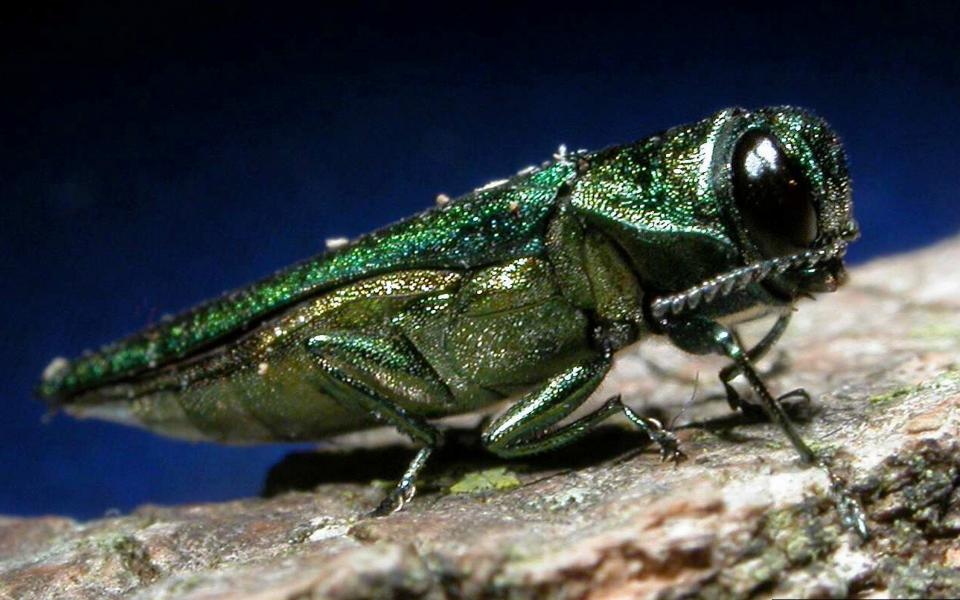Maine regulators are considering a proposal to continue slowing the spread of the invasive emerald ash borer parasite that is killing the state’s ash trees.
The new rules would expand the areas where Maine’s Department of Agriculture, Conservation and Forestry, or DACF, regulates the movement of ash products, and extend a ban on bringing materials from infested areas of other states and Canada into non-regulated parts of Maine. The rules would also lift restrictions on the movement of composted or uncomposted ash chips in all parts of the state.
The proposal comes less than two months after the federal government lifted a quarantine on ash products in nearly two dozen states where the insect has been found. The U.S. Department of Agriculture called that approach ineffective and in January announced plans to use parasitic wasps — which kill the ash borer by laying eggs in or on those of the ash borer — to eliminate the invasive species.
Maine officials argue wasps mostly protect young ash trees and cannot fully replace restrictions on the movement of ash products. The Bureau of Forestry issued an emergency order in January to extend the quarantine until stricter state rules could be adopted.
“The parasitoid wasps are not a solution for the existing trees,” said Gary Fish, state horticulturist with the agriculture department. “They’re not nearly as effective on older trees as they are on younger trees.”
Fish explained that thin bark on young ash trees allows wasps to easily lay their eggs over emerald ash borer territory, while thicker bark on older ash trees is harder for the wasps to penetrate and parasitize. He also pointed out that wasps can’t be released until ash trees have been significantly damaged by emerald ash borers because the wasps need a food source to establish their population.
“By the time you release the wasps, most of the trees are already destined to die,” said Fish.
While emerald ash borer was first discovered in Michigan in 2002, Maine was able to keep the parasite killing ecologically and culturally sacred ash trees out of the state until it was discovered in Aroostook County in 2018.
Dr. John Daigle, University of Maine professor in the school of forest resources, credits Maine’s proactive quarantine rules, such as firewood restrictions, as the main reason for being able to fend it off so long.
“It’s really been a big effort to try to control, as best as we can, the movement of infested firewood,” said Daigle. “It’s a direct result of the quarantine, and information and education that’s been sent to people.”
Daigle and Fish both highlighted the cultural significance of black ash trees as part of the creation story for Wabanaki tribes of Maine and resource used for traditional Wabanaki basket weaving.
“Losing ash will be a blow to a lot of aquatic and wetland organisms as well as an extremely large hit for the Native American populations in Maine,” said Fish. “We want to make sure for the future that we can basically control what might come across the border.”
Ninety percent of ash trees in Maine are not in infested areas, but the parasite has been found across New England. Quebec and New Brunswick also have significant populations. While Cumberland, York and towns in the southwest corner of Oxford County have had emerald ash borer exposure, Aroostook County has been hit the hardest.
The Department of Agriculture, Conservation and Forestry presented three options for expanding the quarantine in Maine’s northernmost county at a virtual public hearing March 16. The most conservative option expands the quarantine area by three towns, while the most extreme would add 36 towns and territories.
The new rules would also no longer regulate the movement of chipped wood in areas under quarantine because regulators have deemed the practice as low risk.
Administrators will collect and respond to public comments, and work with the DACF commissioner and attorney general to decide which option and potential rules changes will be best.
If there are no comments that would change the proposal significantly, the new rules will then be sent to the secretary of state to be posted and will become effective five days later.
Public comments can be submitted to vog.e1758204768niam@1758204768hsif.1758204768yrag1758204768 or Gary Fish, Maine DACF – Horticulture, 28 State House Station, Augusta, ME 04333-0028 until 5 p.m. on April 2.
Regulators fine Electricity Maine $500,000 and halt marketing operations
A regulatory ruling decided Electricity Maine can’t market electricity plans to residential customers for a year. The company was levied a $500,000 fine and other penalties for violations of consumer protection laws.
The company is Maine’s largest independent residential electricity seller. It pioneered the market in 2012 and quickly grew, offering customers slightly lower prices.
But since 2013, the company’s rates have exceeded the default rate, called the standard offer. The company’s customers would have saved $114 million with the standard offer, based on an analysis by The Maine Monitor.
Electricity Maine’s latest regulatory troubles began with complaints about a door-to-door marketing campaign it hired a contractor to run.
Regulators and local police documented cases where salespeople posed as representatives of utilities, such as Central Maine Power Co. The complaints were also part of a class-action lawsuit that accused the company of overbilling.
Regulators also permanently banned Electricity Maine from any door-to-door marketing. The ruling also requires the company to allow customers signed up through the campaign to move back to the standard offer with no termination fee.
Maine Coast Fishermen’s Association donates 200,000 seafood meals
As restaurants shut down with the onset of the coronavirus pandemic a year ago, Maine’s groundfish fleet began tying up its boats because markets were down. While fishermen weren’t able to land fish and make a profit, some Mainers were also struggling to put food on the table.

“We were reading all these horror stories about the number of people that were going hungry in Maine,” said Ben Martens, executive director of the Maine Coast Fishermen’s Association.
To address the lack of fish being landed and Mainers going hungry, the Maine Coast Fishermen’s Association was awarded an anonymous $160,000 grant in September 2020. The nonprofit raised more funds from private donors during its fall fundraising campaign and secured $200,000 from Gov. Janet Mills through CARES Act funding to support shoreside businesses and keep families fed.
They partnered with the Good Shepherd Food Bank to feed underserved communities in Maine and support fishermen through the holiday season.
“Trying to help support fishermen when prices are poor and get food to those in need is … it’s really just been one of those fantastic opportunities,” said Martens.
The group recently announced it has been able to donate over 200,000 fresh and frozen meals during the past six months. While the work has been fulfilling, Martens said the demand is increasing.
“We have more and more groups and individuals reaching out to us to see how they can participate in the program to receive donations,” said Martens.
The Fishermen’s Association plans to keep the project going the rest of the year and continue to solicit donations that keep Maine fishermen on the water and communities across the state fed.
Regulators and citizens consider sweeping dam removal on lower Kennebec
Concerns over how four hydro-powered dams are affecting fish population on the lower Kennebec River has prompted Maine’s Department of Marine Resources (MDMR) to open its Kennebec River Management Plan for public comment. As is, the report recommends removing two of the four dams along the lower Kennebec River between Waterville and Skowhegan.
One of the two dams MDMR is recommending to shut down — the Shawmut Project — is up for relicensing with the Federal Energy Regulatory Commission, which could renew operation for another 30 to 50 years.
The report also discusses removing all four dams to support five struggling species of diadromous fish, which move between fresh and saltwater environments during their life cycles. Species of concern include endangered Atlantic salmon and the recovering species of alewife, blueback herring, American shad, sea lamprey and American eel.
Colin Woodard of the Portland Press Herald reported that while MDMR does not typically recommend dam removals, “the fate of river-run fish in the Kennebec River watershed and quite possibly that of Atlantic salmon in the United States,” is at stake.
The Wabanaki Nations support the removal of all four dams as the first step toward restorative justice for the fish but told Mali Obomsawin of the Daily Bulldog that, “the plan does not go far enough.”
The Wabanaki hope to see the fishing grounds restored to support their sustenance fishing rights that depend on the preservation of several interconnected and culturally significant waterways.
The Natural Resources Council of Maine (NRCM) also voiced concern that the Canadian energy company, Brookfield Renewable Energy Partners, “owns the four dams that block access to some of Maine’s best fish spawning and rearing habitat.”
A press release from the NRCM pointed out that, “the dams represent only 6 percent of Maine’s overall hydroelectric capacity and are increasingly unnecessary as the state accelerates the transition to solar and wind energy to combat climate change.”
A virtual public hearing on amendments to the management plan was held this week and written comments must be submitted by March 27. Comments can be emailed to vog.e1758204768niam@1758204768gnika1758204768melur1758204768.RMD1758204768 or mailed to the Maine Department of Marine Resources Attn: Amanda Ellis 21 State House Station Augusta, ME 04333-0021.
Darren Fishell contributed to this report.







